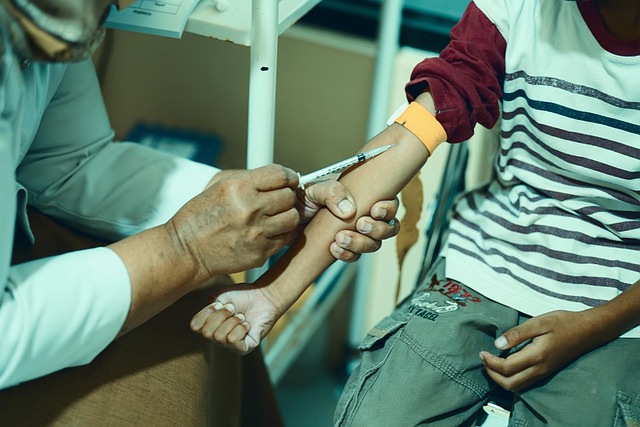Prolotherapy stimulates tissue repair for chronic joint pain, especially rotator cuff injuries, through targeted injections, offering a non-surgical solution for persistent discomfort despite conservative treatments. Risks include temporary pain and swelling, but long-term studies show sustained relief and improved function for many patients.
“Explore the potential of Prolotherapy as a game-changer in managing shoulder injuries and rotator cuff pain, especially for those suffering from chronic joint pain. This alternative therapy has gained attention for its ability to stimulate tissue repair. In this comprehensive guide, we’ll delve into how Prolotherapy works, its benefits and risks, and the recovery process, offering insights for individuals seeking relief from persistent shoulder discomfort. Understanding this treatment can empower you to make informed decisions about your chronic joint pain management.”
Understanding Prolotherapy for Shoulder Pain
Prolotherapy, also known as proliferative therapy, is a non-invasive treatment approach designed to alleviate chronic joint pain, particularly in the shoulder area and rotator cuff. This method involves injecting a solution into the affected joint spaces, stimulating the body’s natural healing response. The key ingredient in this solution is typically a dextrose or salt water mixture, which serves to promote inflammation and attract growth factors to the injured site.
By understanding how prolotherapy works, individuals suffering from persistent rotator cuff pain can explore an alternative treatment option. This therapy aims to restore the body’s natural healing mechanisms, encouraging tissue repair and strengthening the shoulder joint. It is particularly beneficial for those who have not found relief through conventional treatments like rest, physical therapy, or medication.
How Prolotherapy Treats Rotator Cuff Injuries
Prolotherapy, also known as proliferative therapy, is a non-invasive treatment that focuses on stimulating the body’s natural healing process to alleviate chronic joint pain, including rotator cuff injuries. This therapeutic approach involves the injection of a solution into damaged soft tissues, typically containing dextrose and a local anesthetic. The solution serves two primary purposes: it irritates the tissues, triggering an inflammatory response that draws in stem cells and nutrients essential for tissue repair; and it helps to relax the muscles surrounding the joint, reducing strain on the rotator cuff.
By promoting the body’s natural healing mechanisms, prolotherapy can significantly reduce pain levels and improve shoulder function over time. This method is particularly beneficial for individuals suffering from chronic rotator cuff pain that has not responded well to conservative treatments such as rest, physical therapy, or anti-inflammatory medications. Through repeated sessions, prolotherapy encourages tissue regeneration and collagen production, leading to stronger, healthier connective tissues and a reduced risk of future injuries.
Benefits and Risks of This Alternative Therapy
Prolotherapy, also known as proliferative therapy, offers an alternative approach to managing chronic joint pain, including rotator cuff injuries. This non-invasive procedure involves injecting a solution into the affected area to stimulate tissue repair and regeneration. One of the primary benefits is its potential to reduce inflammation, promote collagen production, and alleviate pain associated with tendonitis or partial tears in the rotator cuff muscles.
However, like any therapy, prolotherapy is not without risks. Potential side effects include temporary pain, swelling, and bruising at the injection site. In rare cases, complications such as infection, nerve damage, or excessive scar tissue formation have been reported. It’s essential to weigh these risks against the potential benefits, especially for individuals seeking long-term solutions for persistent shoulder discomfort.
Recovery and Long-Term Prognosis for Chronic Joint Pain
Prolotherapy has shown promising results in treating chronic joint pain, including that associated with rotator cuff injuries. While acute pain often responds quickly to treatment, recovery from chronic conditions like rotator cuff tendinosis or partial tears can be a lengthy process. Prolotherapy offers a unique approach by stimulating the body’s natural healing response through specific injections into damaged soft tissues.
The long-term prognosis for individuals undergoing prolotherapy for rotator cuff pain is generally positive. Many patients experience significant reduction in pain levels and improved shoulder function, enabling them to resume normal activities without the restrictions imposed by chronic joint pain. Follow-up studies suggest that the effects of prolotherapy can be sustained over time, providing a non-surgical solution with potential long-lasting benefits for those struggling with persistent rotator cuff injuries and related chronic joint pain.
Prolotherapy shows promise as a non-invasive alternative therapy for managing shoulder injuries and rotator cuff pain, particularly in cases of chronic joint pain. By stimulating the body’s natural healing response, this treatment can potentially offer long-term relief without significant risks. However, it’s crucial to consult with healthcare professionals before undergoing prolotherapy, as individual results may vary. For those seeking a holistic approach to managing persistent shoulder discomfort, exploring prolotherapy could be a valuable step towards improved mobility and quality of life.
